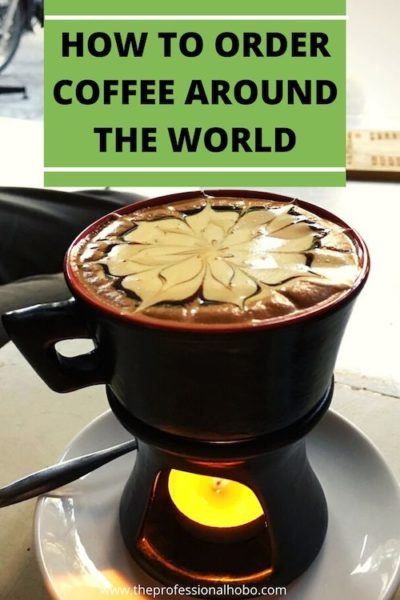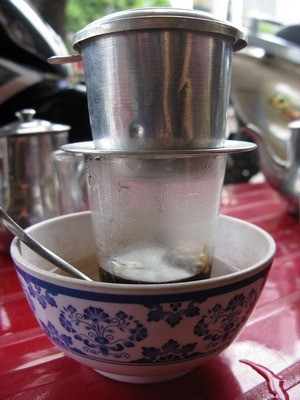I love coffee. I’ve been drinking it in one form or another since I was a teenager. And since I started traveling the world, I’ve been delighted to find it served in many different forms, accompanied by different customs and coffee drinking rituals.

This post was originally published in 2016. It has since been updated for accuracy of links and content.
For example, on leaving North America, I discovered that their commonplace filtered coffee is considered to be little more than “dirty tap water” in many countries; often thought of as a downright abomination of this glorious brew. The idea of a “bottomless cup” of coffee as is served in many North American restaurants is a completely foreign concept in many other countries.
In parts of Asia, I had trouble finding much other than instant coffee (which I consider a downright abomination of even filtered coffee).
In Australia and New Zealand, it took me ages to figure out how to even order a cup of coffee. There’s the “flat white”, the “long black”, and various other incantations that took me a while to decipher.
This was my introduction to the concept that coffee, in many places, is espresso-based. All coffee is based on a simple shot of espresso, to which you add water, milk, or steamed milk in various amounts to formulate your concoction of choice.
In Italy, I got dirty looks for ordering a cappuccino after a meal. Cappuccinos are reserved solely for morning libations; at all other times of day you drink espresso, often with an eye-poppingly large amount of sugar.
In Vietnam, I met my match in coffee. My favourite thing to do in the mornings was to sit on the sidewalk in a toddler-sized chair and watch the world go by at a furious pace, while my coffee slowly dripped into a glass with condensed milk at the bottom. The flavour and texture of the coffee in Vietnam (condensed milk aside – which is pretty freaking fantastic in coffee) is something that I’ve yet to find anywhere else.
As a microcosm of world travel in general, I’ve enjoyed discovering the number of different ways people view – and drink – coffee according to local customs, cultures, and history.
Coffee Drinking Rituals Around the World
Following is a cool infographic that depicts the form and manners of coffee drinking rituals in various countries. Although I discovered many of these customs the hard way, you can use this primer as a way to avoid your own cultural faux pas and drink coffee around the world like you’ve been doing it all your life.

foodpackaginglabels.net
Where is the best coffee you’ve had in the world?



Nice piece to read as I’m sitting here in the morning sunshine, listening to the birds while drinking my cup of drip coffee in the SE part of the USA.
I used to drink (American) coffee all day long, maybe a gallon or so in the course of a day, now that I’m older it’s my one large cup in the morning unless there is something special going on. I had some expresso after dinner at an Italian restaurant a couple of weeks ago, my companion explained that it was traditional. I thought it was a great idea!
Hey Rob,
Although I love the idea of finishing dinner with espresso, like you, I don’t tend to drink coffee other than in the morning (or in “emergency” scenarios during the day when I need a caffeine boost)! I’m always afraid that coffee (or worse – espresso) at night will make for a bad sleep. But many cultures in the world seem to get away with it – not the least of whom are Italians! So maybe I should give it a shot (so to speak). 😉
I freaking LOVED Cambodian coffee. I remember asking “Is this a mocha?” because it always tasted like it had chocolate!! To this day, I still don’t know what made it taste like that and even tried to find some, but to no avail. And it wasn’t just the condensed milk bc in countries like Thailand and Vietnam where they also use condensed milk, it still tasted different!
Hi LeAnna,
I found the same mocha taste in Vietnamese coffee – that’s why I loved it so much. It was like mocha velvet. YUM! Good to know it’s in Cambodia as well. 🙂
Such a great read being a coffee enthusiast this rang close to home and i think i shall try each ritual when i can 🙂
Xplorato – sounds like a great way to explore the world….one cup of coffee at a time…. 🙂
I’m with you Nora, on Vietnamese coffee being my world-wide favorite. And I must say, I’m a little annoyed with you right now, for reminding how much I miss it. 🙂
And yes too, I remember when I lived in France/Italy in the early 80’s, Europeans turning up their noses at U.S. coffee and dubbing it “monkey pee” (which comparatively, back then was a perfect description of it).
But that was pre-Starbuck’s and now the little coffee shop that started in a corner of Pike’s Place in my beloved Seattle – is serving coffee all over Europe and indeed, in most every corner of the world! (though I must say, I’m rather glad the “mermaid” hasn’t yet made it’s way here to Cuenca, Ecuador!) 😉
Hey Dyanne,
You’re absolutely right – espresso-based coffee is much more widely available in North America now….thank goodness!
So….I guess what you’re saying is….I won’t find coffee in Ecuador that is nearly as good as in Vietnam??? 😉
Let’s just say… you won’t find coffee anywhere on the PLANET that’s as good as Vietnam! I think it has something to do with those wee red plastic stools. 😉
Dyanne – My sentiments exactly….especially about the red plastic stools!
I’m the biggest fan of coffee and I love to drink it when travelling! Love the infographic! <3
Agness: Here here! (*sipping coffee*)
Even though I don’t drink coffee, still an interesting infographic … enjoyed learning about rituals around this drink from around the world!
Thanks, Tina!
It is interesting how coffee is consumed / enjoyed at other locales.
My German friends swear by a nightly espresso before bed – “no caffeine”
The two pot gravity balance / steam method used in China made for quite the process. There was nothing quick about it while the unit was meticulously set up, the water boiled out of the heated vessel, the fulcrum sways to the other side as the water boils out of the original pot and condenses into liquid, the grounds steep in the energized water until the system (water and vessel) cools down, at which point the liquid is sucked back out into the original, now cooled, vessel. The fulcrum tilts back to the original position, leaving you to enjoy a nice strong cup of Joe.
No, the bottomless cup is not an option!
Hi Doug,
Wow – that two-pot method sounds awesome! Never thought I’d need to visit China (again) to have a great cup ‘o’ joe. Maybe next time… 🙂
Since I live in Portugal, I am in love with Portuguese coffee, which is as good as the espresso in my native Italy, sometime better, but come always at almost half of the price!
I like also Vietnamese coffee, althogh not so much the red plastic chairs :), and I consider the coffee luwak from Indonesia a kind of scam, but the one I tasted in Laos on Bolaven plateau made by a Dutch man, may be the best I ever had
Hi Clach,
I would imagine the coffee in Portugal would be amazing – and cheap! Mmm…..I’ll be there right away. 🙂